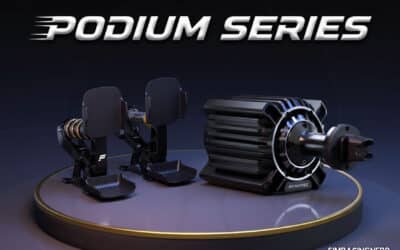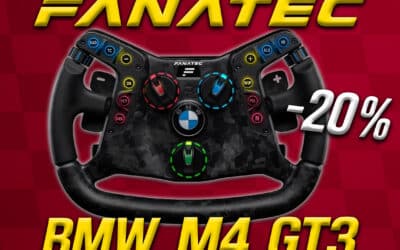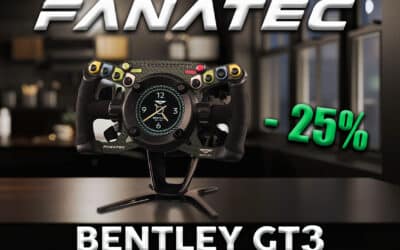German manufacturer of sim-racing peripherals Fanatec is very well known in the game, and very experienced too. It has to be said that Fanatec has more or less dominated the sim-racing world for over 20 years, thanks to its high-quality, reliable and above all immersive premium peripherals. Fanatec’s product catalog is vast, reaching virtually every pocketbook, from Sunday drivers to pro racers with very specific needs.
The German brand’s ecosystem is both complete and works perfectly with its products. You can use virtually any Fanatec sim-racing peripheral on your setup, and these will find no difficulty in configuring themselves to each other, adapting and giving you the best possible performance.
For many years now, both in sim-racing and in the automotive industry in general, there have been two parts to a piece of equipment: hardware and software. In the automotive industry, this exists to offer different equipment and options on demand, but it also serves to adapt vehicles to world markets, which are often not the same in terms of needs and legislation: the hardware remains fundamentally identical, but the software can change drastically.
In sim-racing, it’s practically the same thing, and the software allows us to get the most out of our setup. With this in mind, Fanatec has developed its Fanalab sim-racing device management software. In what follows, we’ll take a quick look at this software and its strengths.
What does Fanalab do?
Fanalab is the software used by Fanatec to manage its peripherals and products. As you know, a sim-racing setup consists of at least 3 peripherals: a base, a steering wheel and a pedalboard. You’ll also find a shifter, handbrake, RevLED and other peripherals.
Of course, each product has its own controller or chip to manage its operation. The idea behind adding such a chip or controller is to keep an eye on the data produced by the device and make changes to various parameters. For example, on a Podium DD2 base which develops a maximum torque of 25 nm, with the help of software, in this case Fanalab, and the base controller, we can configure the torque according to our preferences. So you can end up with a Podium DD2 that only develops 15 nm if you want. And that’s why such software is so useful for sim-racing.
Which devices can use Fanalab?
I’m not telling you anything new when I say that Fanatec’s product catalog is very extensive, with over 20 flywheels, 6 bases, 5 pedalboards, as well as other sim-racing peripherals. For the sake of consistency between products, Fanalab is software that can be used with all recent Fanatec sim-racing peripherals, whether from the CSL, ClubSport or Podium ranges.
To put it simply: if it’s branded Fanatec and isn’t 15 years old, Fanalab can be used on it. However, there’s a catch: being software, Fanalab only works on PCs. Fanatec’s sim-racing peripherals allow some configuration of torque outputs on consoles, for example, via the flywheel settings interface, but this is limited. If you want to get the most out of your Fanatec setup, you need to be on a PC.
Fanalab operation and settings
Fanalab is software, so you’ll need to download and install it on your PC. Just do a quick Internet search and you’ll find a download link. A word of advice: only use the latest versions of Fanalab from the official Fanatec website. Avoid forums and other download sites for obvious security reasons.
Once you’ve installed and launched Fanalab, you’ll find a menu on its ” Game Profile ” interface that contains virtually all the sim-racing titles supported by Fanatec’s software. The list is long, and includes arcade, semi-arcade and simulation games. The next step is to select the title in order to obtain telemetric data on its graphics engine and make adjustments to it, such as the steering angle, the intensity of game effects and so on.
Here are a few examples of possible Fanalab settings
- Force feedback power. This parameter adjusts the force feedback developed by the base, as a percentage. The higher the value, the closer to maximum torque the base will produce.
- Max. turning angle Depending on the base you’re using, this allows for a maximum steering angle, which is set via Fanalab. This angle is expressed in degrees (°) and the steering wheel will lock when you reach this value. Think of it as reaching the limit stop when steering a car.
- Game effects intensity. With this setting, you can alter all the effects transmitted by the game via its graphics engine, such as vibrations, shudders, collisions, etc.
- Force feedback calibration. Basically, you’re going to set the DD base to deliver its force feedback in a rough, smooth or in-between manner. This setting is very important on bases developing high power or torque, like the Podium DD2 for example. This calibration allows you to adjust the sensitivity of the force feedback, giving you different feedback for, say, a vibrator, a shock, sand, and all the rest.
- Steering wheel inertia. This setting adds an extra layer of realism, especially if you want to feel the body movements generated by the car’s weight, the lean when cornering fast, and so on.








0 Comments